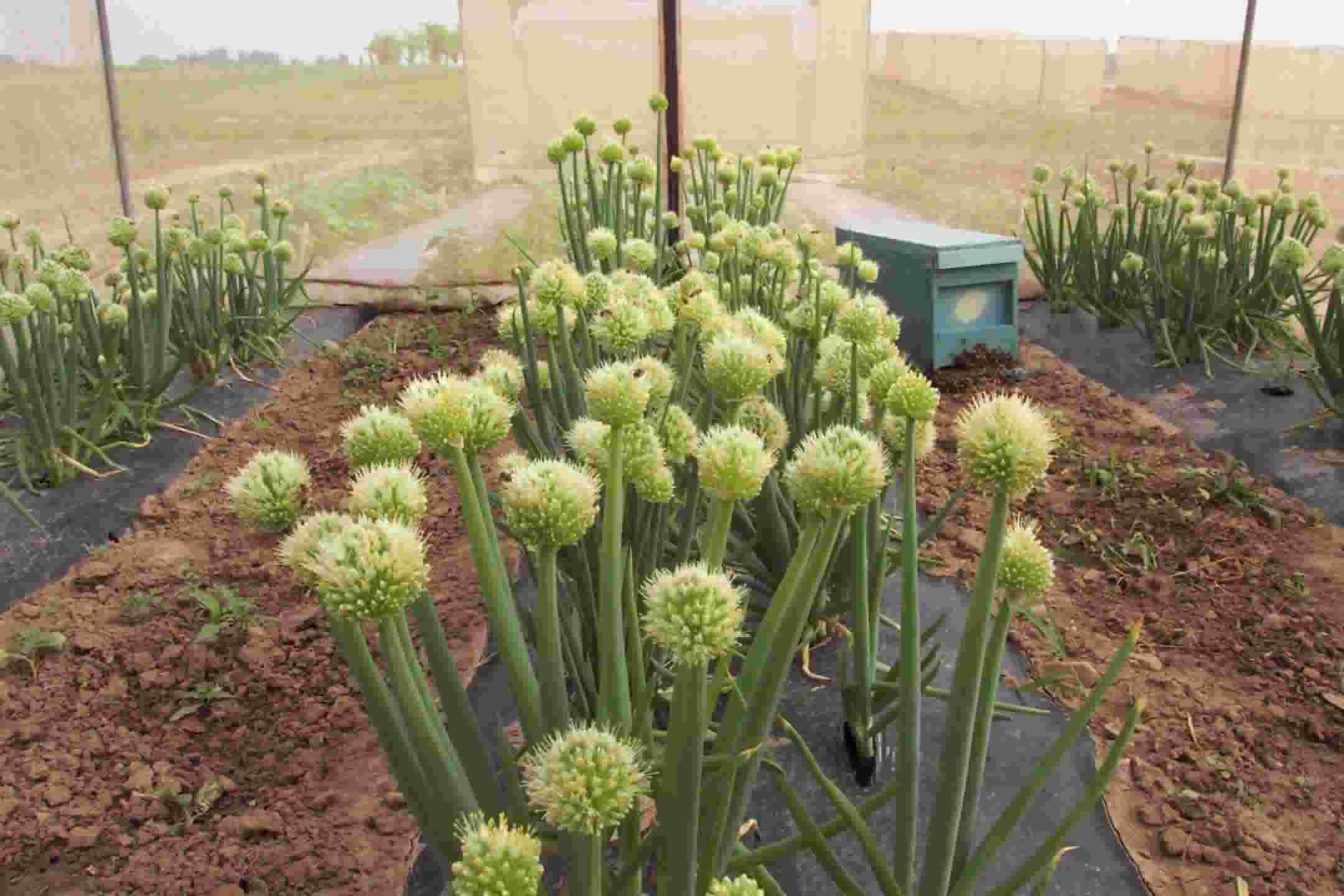| Onion Production |

|
 Allium spp.are members of the family Amaryllidaceae. This genus consists of over 400 species including: ampeloprasum (leek), cepa (common onion), fistulosum (bunching onion), sativum (garlic), schoenoprasum (common chives), and tuberosum (garlic chives).
Allium spp.are members of the family Amaryllidaceae. This genus consists of over 400 species including: ampeloprasum (leek), cepa (common onion), fistulosum (bunching onion), sativum (garlic), schoenoprasum (common chives), and tuberosum (garlic chives).
Alliums have perfect flowers but, can not self-pollinate because the male anthers shed pollen before the female stigma is receptive. Therefore they cross-pollinate via insects (flies and bees) or by manually pollinating (hand-pollinating) the flowers in a controlled environment. Seed producers must keep in mind that varieties of the same species will cross-pollinate with other varieties of the same species. Chives reproduce by division of bulbs and produces seed. To reproduce garlic you must save healthy heads and replant the individual cloves separately. Topsetting or hardneck varieties of garlic will produce a seedhead with bubils. These can be planted, but it will take several successive years to get good-sized heads.
Many alliums (A. cepa) are grown out as biennials (taking 2 seasons to produce seed), and require a  cold treatment (vernalization) in order to flower. It is easiest to grow for seed from bulbs rather than from seeds. Allium seeds are generally short-lived and should be used in 1 or 2 seasons. When planting alliums (or any cross pollinating crops) for seed, care must be taken to isolate same species varieties from one another, either through mechanical isolation (caging, bagging) or by distance isolation. In addition to isolating same species varieties, care must also be taken to preserve as much genetic diversity as possible by planting a minimum number of plants.
cold treatment (vernalization) in order to flower. It is easiest to grow for seed from bulbs rather than from seeds. Allium seeds are generally short-lived and should be used in 1 or 2 seasons. When planting alliums (or any cross pollinating crops) for seed, care must be taken to isolate same species varieties from one another, either through mechanical isolation (caging, bagging) or by distance isolation. In addition to isolating same species varieties, care must also be taken to preserve as much genetic diversity as possible by planting a minimum number of plants.
 You should harvest your seed as soon as the seed heads are dry, if you wait too long, the seed heads will shatter and you will loose all the seed you spent the last 2 seasons growing out! Seed heads can dry in the field if you plan on harvesting several times or be cut and laid out to dry if drying in the field isn't possible. Keep in mind that drying seed in temperatures greater than 94? F will damage the seed and if the drying seed head becomes wet by rain or watering, it will also damage the seed.
You should harvest your seed as soon as the seed heads are dry, if you wait too long, the seed heads will shatter and you will loose all the seed you spent the last 2 seasons growing out! Seed heads can dry in the field if you plan on harvesting several times or be cut and laid out to dry if drying in the field isn't possible. Keep in mind that drying seed in temperatures greater than 94? F will damage the seed and if the drying seed head becomes wet by rain or watering, it will also damage the seed.
Most allium seed heads (leeks and onions) need to be threshed first  (we use a belt thresher but this can be done by hand threshing) and then the smaller chaff can be separated by using screens (see table to the right) or an air column or simply by winnowing. I have also tried pouring the seed in a bucket of water. The light, inviable seed and chaff will float and the viable seed will sink. You can either skim off the top with a sieve or decant the inviable seed and chaff. Immediately after you get rid of the chaff, you want to put the "good" seed into a mesh bag or lay it out on a screen to dry.
(we use a belt thresher but this can be done by hand threshing) and then the smaller chaff can be separated by using screens (see table to the right) or an air column or simply by winnowing. I have also tried pouring the seed in a bucket of water. The light, inviable seed and chaff will float and the viable seed will sink. You can either skim off the top with a sieve or decant the inviable seed and chaff. Immediately after you get rid of the chaff, you want to put the "good" seed into a mesh bag or lay it out on a screen to dry.
